Typically only a few of the legacy 8mm family home movie films that come to us benefit from film cleaning. We have observed that film reels that have been kept in a cardboard box or metal film can through the decades will be in superlative condition. Cleaning will typically not benefit these films. We have found an exception which is the subject of this blog.
A client brought in family home movies that had been taken in a tropical climate (Cuba) and then stored in that country for upwards of 40 years in extremes of temperature and humidity.
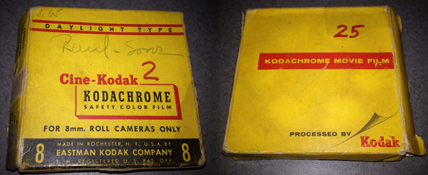
The first thing we noticed when inventorying the films was that many of the boxes looked dusty as if one could simply brush away the dust. Whatever it was, it was firmly embedded into the cardboard and would not wipe away. In addition, many of the boxes had patterns etched on them as if sunlight fell on them through a medium such as a window and etched patterns on them.

The next thing we noticed was that each reel, without exception, had leader with a severe brownish hue as if it had experienced accelerated long-term aging from heat and environmental extremes. All the leaders were also tightly curled such that dependable auto-threading would be questionable. New leader would have to be added to each reel.
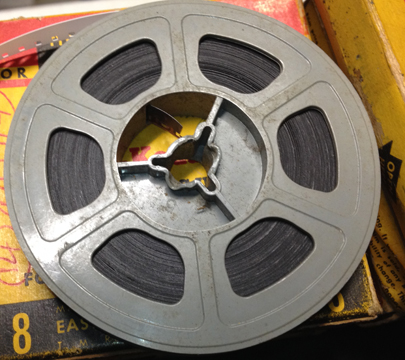 Some of the reels had warping of the outer rim which causes the film to not dependably rewind in a straight track. Two reels had unusual patterns embedded on the hub (shown at right) as if someone had tried to force the reels onto a spindle without first aligning the holes. Also, each reel had a hub with an interference fit such that it was difficult to slip a reel onto the projector’s spindle.
Some of the reels had warping of the outer rim which causes the film to not dependably rewind in a straight track. Two reels had unusual patterns embedded on the hub (shown at right) as if someone had tried to force the reels onto a spindle without first aligning the holes. Also, each reel had a hub with an interference fit such that it was difficult to slip a reel onto the projector’s spindle.
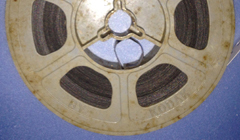 Some of the reels had caked dirt firmly embedded in them as shown in the picture on the right. This suggests that the film on the reel will be in distress. Indeed, film on reels such as this one required extra care in the cleaning process as will be explained later in the text.
Some of the reels had caked dirt firmly embedded in them as shown in the picture on the right. This suggests that the film on the reel will be in distress. Indeed, film on reels such as this one required extra care in the cleaning process as will be explained later in the text.

Upon projecting the films is was found necessary to clean the projector’s film gate after each reel. Shown at right is a typical Q-tip after having removed debris in the film gate from a single reel. Needless to say, the compressed air nozzle was kept at the ready through each projection to blow out uninvited “guests.”
Our philosophy for film cleaning with this batch of films was to first duplicate each reel to digital without any pre-processing of the films, then clean a small sample, re-capture and then compare the results. We believed this was necessary because there were too many unknowns in the films’ chemical history having come from a third-world environment. For example, some of the films were black-and-white even though the film was Kodachrome. This collection of films was exposed between the very late 1950s to the early 1960s when commerce with that region was not dependable. More than likely the processing plant was not always able to get the Kodachrome dyes from Kodak and was forced to forego color processing accepting monochrome imaging.
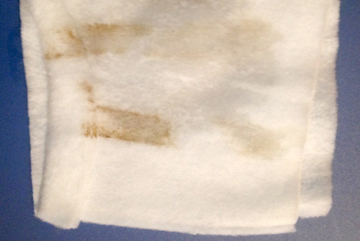 The first step in cleaning was to apply the film cleaning solution to the film using a 100% cotton non-woven pad especially formulated for film. The pad shown on the right illustrates what a typical pad looked like having applied the solution. You can see the obvious collection of oxides. The darker area is wet from the film cleaning solution.
The first step in cleaning was to apply the film cleaning solution to the film using a 100% cotton non-woven pad especially formulated for film. The pad shown on the right illustrates what a typical pad looked like having applied the solution. You can see the obvious collection of oxides. The darker area is wet from the film cleaning solution.
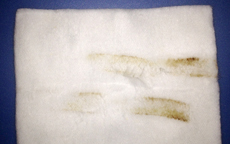 The next step was to begin blotting up excess solution from the film and pickup more film oxides along the way. For this we took a new film cleaning pad and passed the film along it. Shown at right is what a typical pad looked like after having made the first drying pass. We continued this process until we started seeing few oxides showing up on the pad.
The next step was to begin blotting up excess solution from the film and pickup more film oxides along the way. For this we took a new film cleaning pad and passed the film along it. Shown at right is what a typical pad looked like after having made the first drying pass. We continued this process until we started seeing few oxides showing up on the pad.
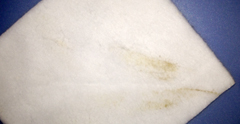 We knew our cleaning process was complete when another drying pass showed a pad with very little oxides. There were some of these reels in this batch that required three solution passes together with four drying passes.
We knew our cleaning process was complete when another drying pass showed a pad with very little oxides. There were some of these reels in this batch that required three solution passes together with four drying passes.
Results are illustrated in the 12 minute video hyperlinked below. Film that is just simply truly dirty exhibits an ever changing pattern of highly opaque and random dust patterns. They are highly opaque, and therefore highly visible, because they lie flat upon the film surface and therefore exactly on the focal plane. You will notice that these patterns are decreased in the cleaned film. Another thing to look for is that in general the imaging is more bright and sharp across the board with these films.
As a side note you will notice a few seconds of footage where complimentary color correction was applied. In this particular scene the original shooter used indoor film for an outdoor scene. We can’t bring back the brilliant color lost because the wrong film was used but at least we can improve what is there.[youtube https://www.youtube.com/watch?v=43cNabU_Zwo&w=560&h=315]
